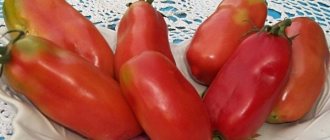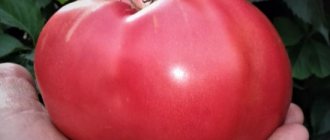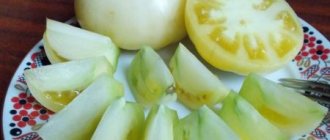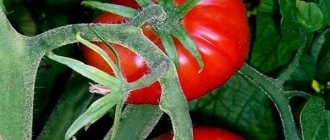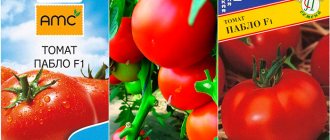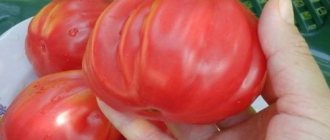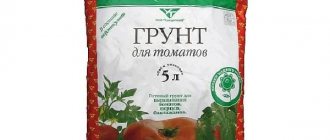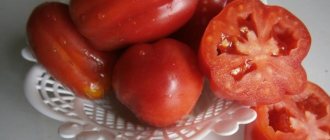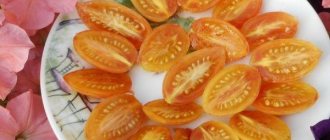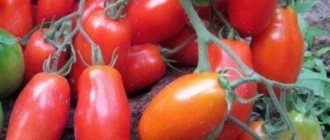Growing vegetable and fruit crops has long become a pleasure for summer residents, and not a necessity to provide food for their families. This is why so much time is spent selecting interesting varieties. The Puzata Khata tomato deserves to be given at least some space in the garden beds. Do you want to know more about the description of the variety from the photo, its characteristics, features of agricultural technology and reviews of gardeners who have already received high fruit yields?
Varietal characteristics
The size of the bushes is average, the height, depending on growing conditions, ranges from 1.5 to 2 meters. The plant is well leafy, with dark green leaves. Inflorescences are intermediate.
The fruits are round-pear-shaped, with an average weight of about 250 grams, collected in clusters of 3-4 pieces. Tomatoes are characterized by pronounced ribbing. The interesting shape and large size of the tomatoes became the reason for such an original name. The fruit resembles a pot-bellied, bloated hut with clear ribs - the corners of the walls.
The color of the fruit is dark red, the pulp has a rich tomato taste, juicy. The high sugar content makes it possible to include fruits in children's menus. Tomatoes are suitable for canning when cut. More often used in fresh salads.
The yield, subject to agricultural technology, is about 11 kg per square meter.
The variety has a number of advantages:
- excellent taste;
- high yield rates;
- excellent resistance to temperature fluctuations.
According to reviews from those who grew it, no significant deficiencies were identified in the variety. Its photo and description are widely distributed on specialized forums for summer residents. Most of the reviews from those who planted are positive.
Fruit characteristics and yield
The Khata Puzata variety is characterized by the formation of large, fleshy fruits. Their weight is 180-230 g, individual tomatoes weigh up to 400 g.
The skin color is bright red. The shape of the fruit is pear-shaped with pronounced ribbing. You can compare a tomato to a full (pot-bellied) bag. The inside of the tomato is multi-chambered, dense, with a small number of seeds. The taste is sweet, rich.
Khata Puzata tomatoes are used for making salads, frying, sauces, and ketchups. Due to the high density of the pulp, tomatoes can be successfully pickled by cutting them into pieces.
Sectional view of ripe varietal tomatoes
The yield in closed ground conditions is 10-12 kg per 1 sq. m. On the street, you can remove 4 kg of tomatoes from each bush.
Growing seedlings
The tomato variety Puzata Khata is cultivated through seedlings. Sowing of seeds begins 2 months before the planned date of planting in open ground. To prevent fungal diseases, the seed material is pre-etched in a solution of potassium permanganate for 30 minutes.
For sowing, prepare plastic boxes with a depth of at least 20 cm and a light nutrient substrate. The soil can be composed of equal parts:
- humus,
- sand,
- leafy soil.
You can also use a ready-made industrial substrate for universal use.
Attention! Seeds are planted to a depth of no more than 0.5 cm. Sowing to a greater depth significantly delays germination time.
After sowing is completed, the box is watered generously with warm water and covered with a piece of film. In greenhouse conditions, seeds germinate in 3-5 days. After seed germination, the film is immediately removed and the box is transferred to a well-lit, warm place.
At the age of 10 days, seedlings are fed with complex mineral fertilizer or humate solution. When applying them, you must strictly follow the recommended dosages according to the instructions. A solution that is too concentrated will burn the plants.
After the development of 2 true leaves, the seedlings are planted in separate containers or larger boxes.
Immediately after picking, the seedlings are protected from direct sunlight. After the plants begin to grow, apply fertilizer. For example, you can use humate or urea. By the time of planting, each plant should have 3-4 well-developed leaves and the beginnings of flower clusters. 2 weeks before the planned planting, the seedlings are hardened off - the plants are taken out onto the veranda or balcony. The time spent outdoors is gradually increased.
Description of tomato Puzata Khata
The variety has been registered in the State Register since 2013. A group of breeders led by Vladimir Kachainik succeeded in breeding it for the first time a year earlier. The originator was , which produces seeds under its own brand. The plant is indeterminate, i.e. its growth height is unlimited. According to reviews from summer residents, the Puzata Khata tomato variety in greenhouses did not exceed the 1.7 m mark. This is explained by weak stems and sparse bushes that do not produce lateral growth. For stability, supports from vertical poles are used, since the tomatoes lie down under their own weight. Without the formation of a bush, the plant's forces go into the foliage and stem, and not into the formation of fruits.
The foliage of Puzataya Khata is average, the shoots are dark green, which is convenient during harvesting, since the tomatoes are clearly visible on the bush. The peduncle is without articulation. The fruits are set on inflorescences of an intermediate type. The brush can hold up to 5 tomatoes. Grow a tomato bush with 1 stem if the goal is to get large fruits and if the plants are close together in the garden. In other cases, leave the stepson under the first flower brush. The variety is early, so at the beginning of spring, seedlings are planted in greenhouses or later transferred to open ground.
Note! The tomato variety Puzata Khata has not been zoned. But it is planted in open ground only in the southern region. In the middle zone and Moscow region, greenhouses or film shelters are built for bushes.
Description of fruits
The variety got its name due to the shape of the fruit. In appearance, they resemble a swollen pumpkin, bright red in color with an orange tint when ripe. Unripe tomatoes are brown without a spot at the base. The weight of one tomato is up to 300 g. The juicy and fleshy pulp can be transported in plastic or wooden boxes when placed in two rows. The taste of tomatoes is sweet with mild sourness. The fruit has 4–6 seed nests. The first fruits are larger than those that ripen later. The size depends on the correct formation of the bush, air temperature, fertilizing and planting density.
Note! The record weight of one fruit of the Puzata Khata variety is 800 g.
The skin of tomatoes is dense, which compensates for the weight of the tomato and its size. It cracks due to improper watering or heavy rain. According to the characteristics of the variety and the description of summer residents, there are voids in the fruits of Puzataya Khata, which reduces the value for seaming for the winter. According to breeders, early-ripening tomatoes ripen 100 days after planting. In fact, tomatoes reach consumer value late when there is insufficient sunlight. This is noticeable for plantings in the greenhouse and under cover. Plus features - the fruits are harvested before late autumn frosts, if there is heating in the greenhouse.
Care after disembarkation
According to the stated characteristics, the tomato variety Puzata Khata is indeterminate. Therefore, when leaving, special attention should be paid to formation.
Bush formation
To obtain high yields, the variety is grown in one stem, less often in two:
- In the first case, all the stepsons on the bush are removed.
- In the second, one well-developed shoot is left. The remaining shoot also needs to be shaped - after laying the first flower cluster, all the stepsons on it are removed. With this formation, tomatoes grow larger.
Attention! If the growth of green mass is not controlled, a large number of side shoots develop on the bushes. As a result, the fruits become smaller and fruiting is greatly delayed.
Watering, mulching the soil
When growing tomatoes, timely watering is necessary. The plant requires especially a lot of moisture at the time of flowering and fruit formation. Excessive dryness during this period can cause flowers and ovaries to fall off.
On average, tomatoes are watered at least once a week. Each bush uses half a bucket of water. To retain moisture in the soil, additional mulching is carried out. Straw and peat are used as mulch.
Attention! As soon as the tomatoes begin to ripen, the amount of watering is reduced. Excess moisture at the time of filling will cause cracking of the fruit.
Harvesting
Tomatoes are harvested as they ripen. Fruits harvested in the milky ripeness phase are stored better. Fully ripened ones are suitable only for processing into tomato products. According to reviews from those who planted Puzata Khata tomatoes, they are able to ripen well after picking.
Advantages and disadvantages of the variety
Tomato Puzata Khata has a lot of positive qualities:
- original shape of the fruit;
- sweet taste;
- contains a large amount of useful substances;
- large fruit;
- good yield;
- excellently withstand transportation;
- are not subject to cracking;
- are stored for a long time without losing commercial quality;
- good immunity to diseases, in particular late blight.
The only disadvantages of the variety include its demandingness regarding the composition of the soil, and the need for the formation and tying of bushes.
Pest and disease control
Most tomato diseases occur due to errors in care. The most common diseases are discussed in detail below. According to reviews from summer residents, tomatoes suffer little illness and are resistant to late blight, rot, and cladosporiosis.
Blackleg
Dangerous fungal disease. It mainly affects seedlings and young immature plants. In most cases, the pathogen is introduced with poorly treated soil. If the growing conditions are met, the fungus does not manifest itself in any way. But when humidity rises, the fungus wakes up and begins to multiply rapidly. As a result, the root collar of the seedlings is damaged and they die.
Affected plants look as if someone has chewed them off near the surface of the soil. A photo of typical lesions is presented below. Fungicides are used to control blackleg. But in the phase of active spread of the disease, they are almost useless. The best protection against blackleg is timely prevention.
Pests
Even if the growing conditions are observed, in some unfavorable years, tomatoes can suffer from insect pests.
Aphid
A small sucking pest, depending on the species it can be black or green. It feeds on the juice of young shoots and leaves. With severe damage, plants begin to experience nutritional deficiency, resulting in the shedding of leaves and ovaries. Garden ants contribute to the active spread of aphids. Therefore, the fight should begin with their destruction. Insecticides used for treatment:
- Commander,
- Aktara,
- Tanrek.
They are bred in strict accordance with the attached instructions. In most cases, a single treatment is sufficient. In case of severe infection, tomatoes are sprayed twice with an interval of 10 days.
Whitefly
Small sucking pest. Actively damages all parts of plants. Due to its very small size, its spread is noticed only at the stage of severe infection. Seedlings and adult plants can suffer from whitefly. To destroy the insect, systemic insecticides are used: Aktara, Komandor, Tanrek. Depending on the degree of infection, treatment is carried out 2-3 times.
Description of the variety
Early ripening tomatoes Puzata Khata are the product of the selective work of agro biologists. The variety was included in the State Register of Russia in 2013. Suitable for cultivation indoors in the northern regions and outdoors in the southern regions.
The photo shows Puzata Khata tomatoes.
Bushes
It has stems of moderate thickness, resulting in lodging of the plant when the bush grows at its maximum. To prevent lodging, it is necessary to use the bush garter method.
This action will help preserve the fruits from rotting. The plant has an average foliage index and moderate growth of bush branches. Refers to species with unlimited growth.
Tomato bushes “Puzata Khata”
Interesting to know! According to reviews from gardeners, the tomato bush does not exceed 170 cm in length.
Flowers and fruits
During the active period, the tomato variety produces numerous flowers. After flowering, fertilization occurs and ovaries are formed.
The fruits get their name from their appearance. They resemble a pot-bellied pumpkin with ribs all over the tomato. When ripe, they acquire a bright red hue, and the fruit weighs up to 300 grams.
The tomato tastes sweet with a slight sourness. In a section it has up to 6 nests with seeds. As a result of proper care, large specimens are obtained. The first offspring differs in size from the subsequent ones.
Puzata Khata has a thick skin that holds the contents of the fruit inside. However, cracking may occur if oversaturated with water. According to tasters, tomatoes have more sugar than acid.
As a result, the fruits can be consumed without fear of allergic reactions. Sufficient maturity can be acquired by storing unripe fruits on a windowsill.
Taste qualities of tomato
Many people find the taste of the fruit bland. There is no acid in it. This allows the fruits of Puzata Khata to be used in children's and dietary nutrition. The taste is rated 4 points by experts.
Peculiarities
The bushes are indeterminate, growing up to 2 m in height in greenhouse conditions and up to 1.5 m in the garden. Thin stems require garters to a trellis or supports, as they can break under the weight of large fruits. To obtain a rich harvest, plants are pinched and formed into 1-2 stems.
The leaves are medium sized and dark green in color. The type of inflorescences is intermediate. The peduncle is without articulation. On each bush, ovaries with 4–6 nests are formed.
Area of application of fruits
Preference is given to fresh tomatoes, which are used in salads or slices. The latter look attractive on the holiday table due to the shape and color of the tomato. Whole Puzata Khata fruits are not covered for the reasons mentioned above. Zakatki are made from cut berries into 4 parts. Tomato juice turns out sweet, which reduces the required portion of sugar. The product, ground through a sieve, is given to children to replenish vitamin reserves during the winter. The variety is suitable for cultivation for sale. For transportation, containers of increased size are used due to the characteristics of Pot-bellied Hut tomatoes.
Transportability
According to numerous reviews from gardeners, it follows that the Puzata Khata variety differs from its analogues in its resistance to transportation and prolonged storage.
The skin of the fruit retains its contents for a long time. Even shaking is not capable of damaging the fruits of the plant. storage for up to 3 weeks does not affect the density, pulp and consistency of the tomato.
Planting and care
Tomato seeds are sown for seedlings 60-65 days before the bushes are sent to a permanent place.
The grains do not have the best germination rate, so they are first soaked in a solution of Zircon, Epin or another stimulant.
If the seed is collected independently, it is also worth treating it with hydrogen peroxide or a solution of potassium permanganate against fungi, viruses and bacteria.
Sow in nutritious light soil containing turf soil, humus, peat, sand and fertilizers. They are buried by 1 cm, slightly moistened and, covered with film, placed in a warm place at a temperature of +22-25 degrees. When sprouts appear, the temperature is reduced for a week, and the boxes are moved to a well-lit place.
Once a week, seedlings are fed with Baikal, Siyanie or humates. When the seedlings have 2-3 leaves, they are picked, for which peat pots are recommended.
3 plants are placed in a permanent place, supports are installed nearby, to which in the future both stems and individual clusters with heavy fruits can be tied.
Water at room temperature with water, loosen and mulch the soil, regularly feed the bushes with nitrogen preparations, and with the beginning of flowering and fruiting - with phosphorus and potassium preparations.
